This post may contain affiliate links. Please read our disclosure policy.
This easy gluten free cornbread recipe will give you the perfect balance of delicious sweetness and melt-in-your-mouth crumbly softness. It's the perfect side for nearly any meal, from soup to BBQ, and it's naturally gluten free if you use all cornmeal and no other flours.
Need your cornbread to be dairy free? Egg free? I can help with these too! Want to take your GF cornbread to go? Use my tasty recipe to make gluten free cornbread muffins that you can enjoy on the run.

Table of Contents
- What makes this recipe for gluten free cornbread special?
- Is cornbread gluten free?
- What's the best pan for making gluten free cornbread?
- Gluten free cornbread: all cornmeal recipe
- Gluten free cornbread: the cornmeal and corn flour recipe
- Gluten free cornbread: the cornmeal and all purpose gluten free flour blend recipe
- How to serve gluten free cornbread
- Storing gluten free cornbread
- Is this GF cornbread recipe suitable for freezing?
- Gluten free cornbread ingredients and substitutions
- FAQs
- Old Fashioned Gluten Free Cornbread | the original best recipe Recipe
What makes this recipe for gluten free cornbread special?
This recipe was one of the earliest gluten free recipes I shared on the blog, and it's become a staple in so many readers' homes. The recipe has always been simple, and still remarkably adaptable.
Many of you have written to me of the years, telling me that you made it with granulated sugar instead of honey, milk instead of buttermilk or yogurt, shortening or coconut oil (or even vegetable oil!) instead of butter. The recipe has turned out every single time.
It bakes very quickly, especially if you're making it in a cast iron pan, since that conducts heat very well. The sides and bottom of the cornbread also brown very nicely in the oven.
Is cornbread gluten free?
Corn itself does not have gluten in it, so it’s naturally gluten free. Cornmeal is made by simply grinding yellow corn into a coarse or fine grind.
For complete information on which grains and other ingredients are naturally gluten free, please check out my Ultimate Guide to the Basic Rules of a Gluten Free Diet. It’s a great way to begin a gluten free lifestyle on the right foot.
By this logic, making cornbread gluten free requires no extra thought, right? Unfortunately, that's not the case. You first have to be careful about the cornmeal you buy to ensure that it isn’t contaminated with gluten-containing grains during manufacturing.
Bob’s Red Mill brand has a certified gluten free cornmeal variety, so if you buy that brand be sure to pick up the right package. Most cornbread is made from cornmeal and wheat flour, so it’s not actually gluten free.
The only flour in my original “old fashioned cornbread” recipe is coarsely ground yellow cornmeal. There's no wheat flour, so it’s naturally gluten free.
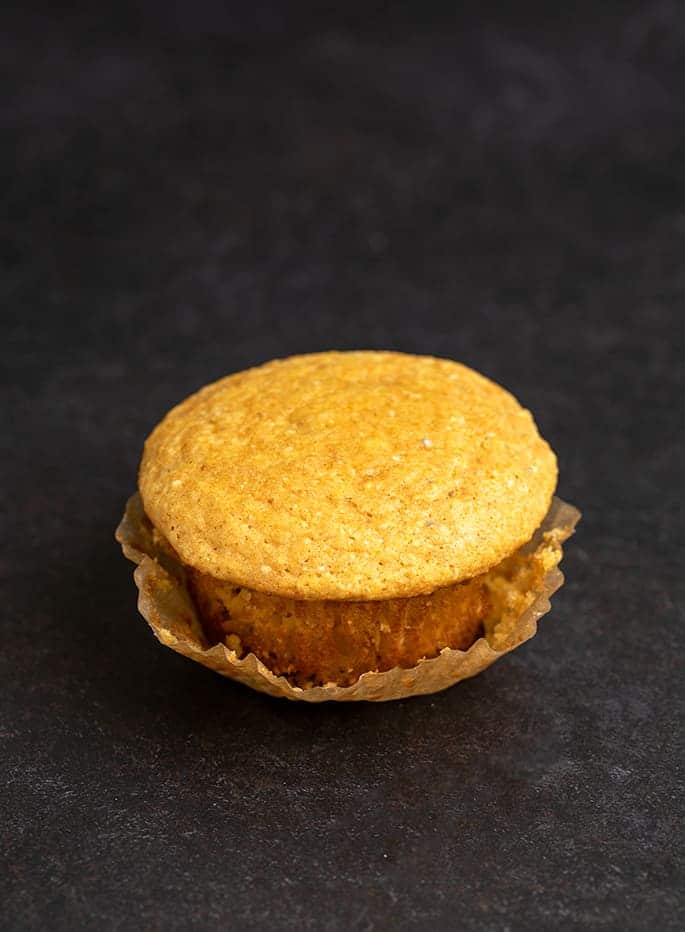
What's the best pan for making gluten free cornbread?
Cast iron skillet. Cake pan. Muffin tin.
These are all possibilities for making GF cornbread, but which is the best? I've made this easy gluten free cornbread recipe in nearly every container imaginable.
My favorite way by far is my cast iron skillet — I love my pan, and I find myself using it nearly every day. And as with many things, it does a superb job with this gluten free cornbread. I'm talking quick cook time, crunchy edges, and lovely color.
But if you don't have a cast iron pan, you have plenty of options. A round 9-inch cake pan works well too. The only difference I notice between my cast iron pan and cake pan is that bread doesn't get as crunchy around the edges when I use the cake pan. If you're not a fan of too much crunch, try a cake pan instead!
Believe it or not, I hadn’t tried this gluten free cornbread recipe in a standard 12-cup muffin tin — until recently. And no surprise, they turned out beautifully.
Making gluten free cornmeal muffins
To use this same recipe to make muffins, I lined the wells of the tin with greaseproof paper liners so the muffins didn’t stick, and distributed the batter evenly among the wells. In my muffin tin, the wells were nearly full of batter.
This isn’t a high-rising cornbread, so I wasn’t concerned that the gluten free corn muffins would overflow the pan. I made the variation with half coarsely ground yellow cornmeal and half corn flour, as discussed below.
The muffins rose evenly, and they baked perfectly at 350°F in 18 minutes. I was considering adding another egg, since the batter is looser than an ideal muffin batter, but I wanted to see if it worked as written. And it did!
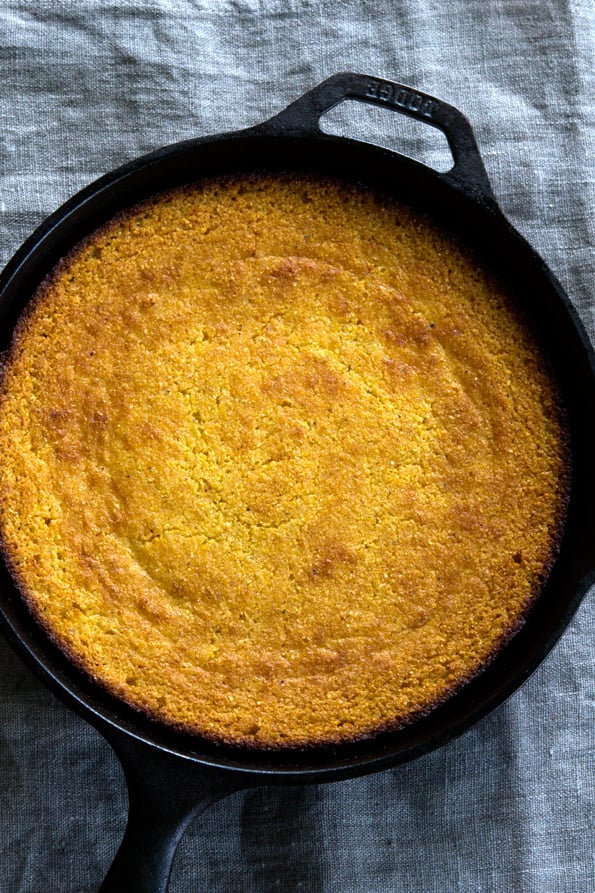
Gluten free cornbread: all cornmeal recipe
This recipe has long been a staple of this blog for so many reasons, not the least of which are because it’s so incredibly simple—and strikingly adaptable.
The original gluten free cornbread recipe calls for 2 cups of coarsely ground yellow cornmeal as the only flour—without any added starches or more finely ground flours.
I call it “coarsely ground yellow cornmeal,” but that’s a bit redundant since cornmeal is simply corn that’s been dried and coarsely ground. All cornmeal is, by definition, coarsely ground.
Made this way, as the recipe was originally written, this classic cornbread recipe is moist and tender, but has a fair amount of “bite” from the cornmeal. The honey helps keep the cornbread tender and helps offset any bitterness from the cornmeal.
None of these variations contain cornstarch, which is a flavorless powder made from only the starch in the endosperm of the corn grain. You could probably replace a bit of the cornmeal with cornstarch and get a more tender cornbread, but I prefer the other variations listed in this recipe.
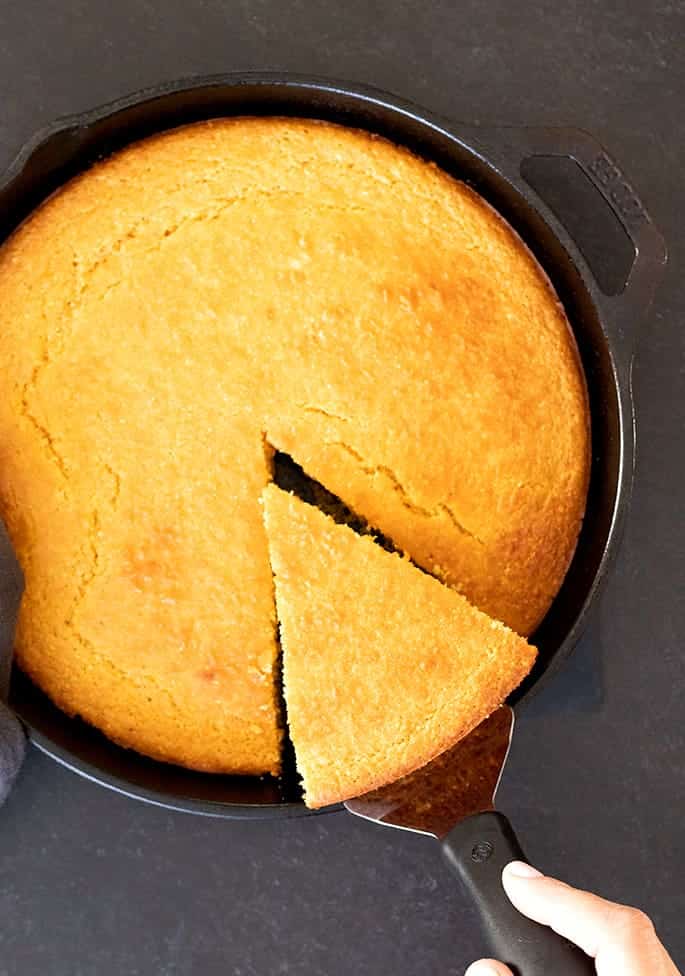
Gluten free cornbread: the cornmeal and corn flour recipe
Cornmeal is coarsely ground corn, and corn flour is finely ground corn. You can buy corn flour, but I generally take my coarsely ground yellow cornmeal and simply grind it again in a blender until it’s lighter.
I consider this variety, made with half coarsely ground yellow cornmeal and half corn flour, to be the best gluten free cornbread of all.
Replacing half of the coarsely ground cornmeal in this recipe with more finely ground corn flour makes for a less crumbly, more cohesive cornbread. It also has a smoother mouth feel, and tends to stay fresh another day longer when stored at room temperature, wrapped tightly.
Since I’ve started experimenting with changing up the flours in this recipe, this variation has become my favorite. I do sometimes buy corn flour if I’m placing an order for other things from nuts.com (where I buy gluten free corn flour), but more often grind my own.
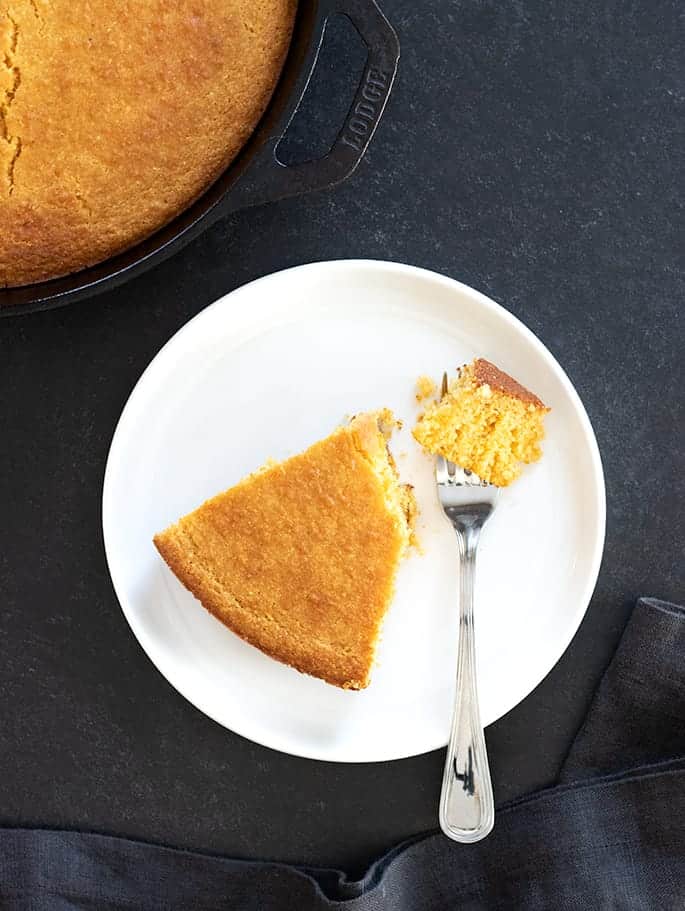
U.K. terminology
To confuse things a bit, I’m afraid that these terms are used differently in the U.K.
In the UK, “corn flour” is actually what we call cornstarch in the U.S. (the starch only).
What you need to look for to make this gluten free cornbread is”coarsely ground cornmeal” (what we simply call “cornmeal” in the U.S.) and “finely ground cornmeal” (what we refer to as “corn flour”). You may also see the latter labeled as “maize flour” or “finely ground polenta”.
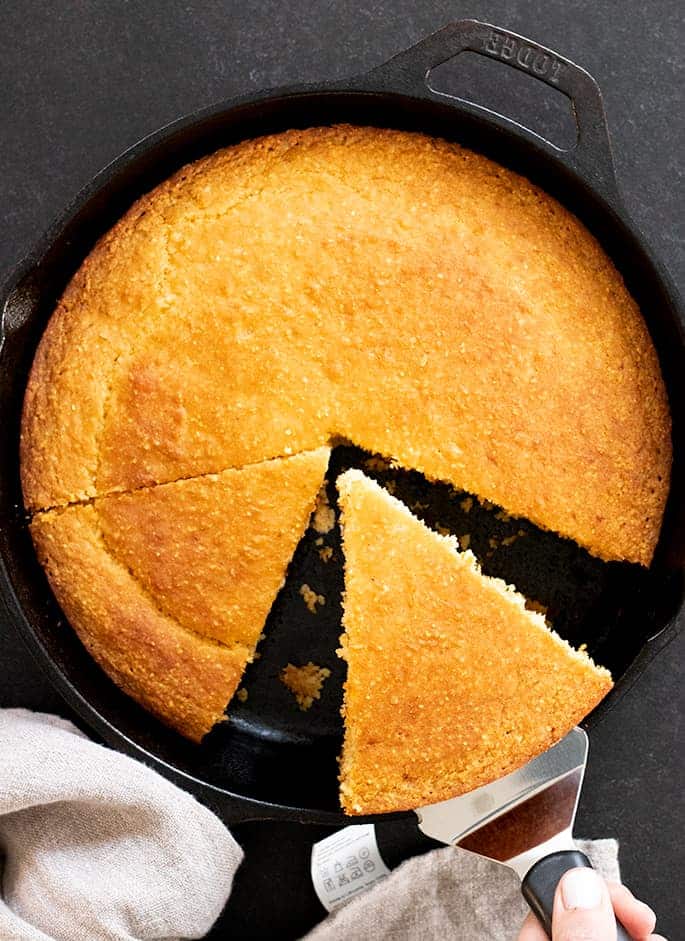
Gluten free cornbread: the cornmeal and all purpose gluten free flour blend recipe
I learned that this recipe could be made with half all purpose gluten free flour (I’ve only used Better Batter, but I’m sure any of my recommended blends would work) when I ran out of cornmeal after I had already prepared all the ingredients to make cornbread.
Since it was only for my family, and my husband will eat anything, especially if it’s warm when I serve it, I decided to try it with half all purpose gluten free flour. The recipe worked (although it took about another 5 minutes to bake fully)!
The all purpose gluten free flour version makes for a cornbread that has a much smaller crumb, and a lighter crumb color overall (although the top is just as yellow). The crust itself is also less crispy.
As you’d expect, it has little bite and is much less chewy than the other two versions. I would not recommend making the cornbread with a combination of all purpose gluten free flour and corn flour, though, as it would not have the right texture.
You’ll also notice that this gluten free cornbread tends to dome more in the center during baking. That’s likely because the combination of flours leads to less even baking, but of course, it doesn’t affect the flavor or texture any further.
How to serve gluten free cornbread
There are so many yummy ways to serve gluten free cornbread, whether you're serving the bread as an accompaniment to a meal or enjoying it on its own.
One of my favorite ways to snack on cornbread is to grab it when it's still hot from the oven and quickly top it with a bit of dairy-free butter. So decadent!
But when I'm craving a bit of sweetness, I drizzle my gluten free cornmeal muffins with extra honey. For a sweet and tangy twist, spread a little strawberry or raspberry jelly instead.
On those days when I need something extra sweet to end my day —hear me out — I warm my cornbread in the microwave for just a few seconds and then drop a scoop of vanilla ice cream on top.
When I'm serving my gluten free cornbread alongside soup, stew, gluten free chili, BBQ, and other meals, I generally offer my family and guests butter and honey, but I find they rarely use them. Instead, they top the cornbread with their meal or use it to soak up the last bits on their plate.
Using gluten free cornbread to make stuffing
If you couldn't already tell, I absolutely love this cornbread, both for its yummy taste and for how versatile it is.
When I need to make stuffing, I often turn to this recipe for a base, and make gluten free cornbread stuffing. It's a great alternative to classic gluten free stuffing, and is often easier to make.
After baking a pan of gluten free cornbread, I let it dry out for a couple of days. Then, I chop it up and add rosemary, thyme, sage, vegetable broth, and a few more ingredients.
Seriously, give it a try at Thanksgiving or the next time you're making chicken or turkey.
Storing gluten free cornbread
I'll be honest, my gluten free cornbread doesn't tend to last long around my house. But when I'm really craving it, I'll make a couple of batches so I can enjoy it throughout the week.
Thankfully, storing this delicious GF cornbread is super easy — just wait until it has cooled completely, and then store it in an air-tight container. I have a plastic container that fits a whole batch beautifully, but zip-top storage bags work great in a pinch too.
If you'll eat your cornbread within two or three days, leaving it outside at room temperature is fine. Any longer than that, I recommend storing it in the refrigerator.
Is this GF cornbread recipe suitable for freezing?
Yes, you can absolutely freeze this gluten free cornbread (or corn muffins, if you go that route).
I've found that if you make this recipe with at least some all purpose gluten free flour, your baked goods will stay fresh for a bit longer and freeze a bit better.
If you make a naturally gluten free variety of the cornbread, without any rice-based flour blend, you should eat it soon after baking, or quickly freeze it for later use. When you're ready to eat it, defrost briefly in the microwave, as even a warm oven will dry out the cornbread.
While you can freeze many non-gluten free cornbread batter recipes, I wouldn't recommend it with mine. It may taste largely the same in the end, but it won't rise as much so it will be quite dense.
Gluten free cornbread ingredients and substitutions
This is such a simple recipe, which often makes substitutions more difficult, but somehow this gluten free cornbread recipe is magic ✨ and can take all sorts of modifications (dairy free, egg free, etc) in stride.
Some following suggestions are from personal experience with this recipe, others are just well-educated guesses.
How to make gluten free dairy-free cornbread
I have successfully transformed this into a gluten free, dairy-free cornbread recipe by using Earth Balance buttery sticks in place of unsalted butter (just reduce the salt by half) and dairy-free plain yogurt in place of yogurt.
You can also try a mix of half plain dairy-free yogurt and half unsweetened almond milk as a buttermilk replacement. That’s your best bet.
How to make gluten free egg free cornbread
As always, whenever there is one egg in a recipe, I recommend trying it with one “chia egg” in its place (1 tablespoon ground chia seeds + 1 tablespoon lukewarm water, mixed and allowed to gel).
I haven’t tried this egg-free, though, so you’ll have to experiment, but I feel pretty confident that you’ll get good results.
Gluten free cornbread — without corn?
Well, this is a super tough one, to make gluten free cornbread without, well, corn. The only reason I think this might be even remotely possible is because I’ve seen some Paleo recipes floating around the Internet that use ground millet in place of cornmeal to make a corn-free “cornbread.”
Perhaps the all purpose gluten free flour variation, which contains only 1 cup of coarsely ground cornmeal, can be made with ground millet in place of the cornmeal.
But note that replacing the cornmeal entirely is a big risk, so only try it if you’re feeling adventuresome
FAQs
Sometimes! If cornbread is made with only naturally gluten free ingredients, like with cornmeal alone, instead of with wheat flour as well, it may be naturally gluten free. Most conventional cornbread will contain some sort of wheat flour, though, and won't be gluten free. You'd need a specific, gluten free cornbread recipe like this one.
Did you let it cool completely before you sliced it? If not, it won't hold together as well when sliced. Did you overmix the batter? That can also create a crumbly, more dense cornbread.
When baked goods rise in the oven and then fall as they cool, they aren't baked all the way through so the center doesn't have the proper structure to support the rise as the steam escapes. Your oven is probably running hot, so the outside of the cornbread is getting overbaked before the center can bake fully.
When your cornbread is done, it will be lightly golden brown on top, golden brown around the edges, and firm to the touch in the center. You can also use the toothpick test by placing one in the center. If it comes out with no more than a few moist crumbs, but no wet batter, it's done.
Cast iron retains heat very well, so less heat is lost during the baking process. In addition, the dark pan attracts more heat than a light-colored pan.
All corn is gluten free. There is something called u0022corn gluten,u0022 but it's not what we mean when we use the term u0022glutenu0022 in the world of u0022gluten free baking.u0022 Instead, when we say gluten, we mean the protein found in wheat, barley, and rye.
If you underbaked your cornbread, it will be gummy in the middle. If you overmeasured baking powder and baking soda, the cornbread will rise too high and then fall, creating a denser, gummy center.
Check your baking powder and baking soda to make sure they're fresh! If not, your cornbread won't rise.
Old Fashioned Gluten Free Cornbread | the original best recipe
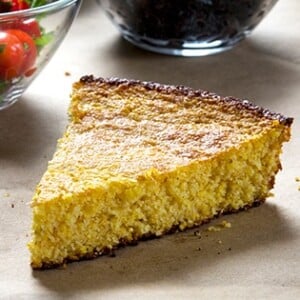
Ingredients
- 2 cups (264 g) coarsely ground yellow cornmeal, (See Recipe Notes)
- 2 teaspoons baking powder
- 1 teaspoon baking soda
- 1 teaspoon kosher salt
- 1 ½ cups (340 g) plain yogurt, at room temperature (can substitute an equal amount of buttermilk or half sour cream/half whole milk)
- 4 tablespoons (56 g) unsalted butter, melted and cooled
- 1 (50 g (weighed out of shell)) egg, at room temperature, beaten
- 4 tablespoons (84 g) honey
Instructions
- Preheat your oven to 375°F. Grease an 8-inch square baking pan or 9-inch cast iron skillet with unsalted butter and set it aside.
- In a large bowl, place the cornmeal, baking powder, baking soda, and salt, and whisk to combine.
- Create a well in the center of the dry ingredients, and add the yogurt, butter, egg and honey, and mix to combine well.
- Pour the mixture into the prepared baking pan or cast-iron pan. Place the pan in the center of the preheated oven and bake for 20 to 25 minutes, or until the cornbread is firm and a toothpick inserted in the center comes out clean.
- If you're baking in a cast iron pan, the cornbread will likely be done in about 20 minutes.
- Slice and serve warm.
Video
Notes
Half of the cornmeal, by weight, can be replaced with an equal amount, by weight of corn flour, and the recipe is otherwise unchaged. You can also replace half the cornmeal, by weight, with all purpose gluten free flour. I like Better Batter as an all purpose gluten free flour here.
Nutrition
Nutrition information is automatically calculated, so should only be used as an approximation.
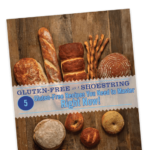
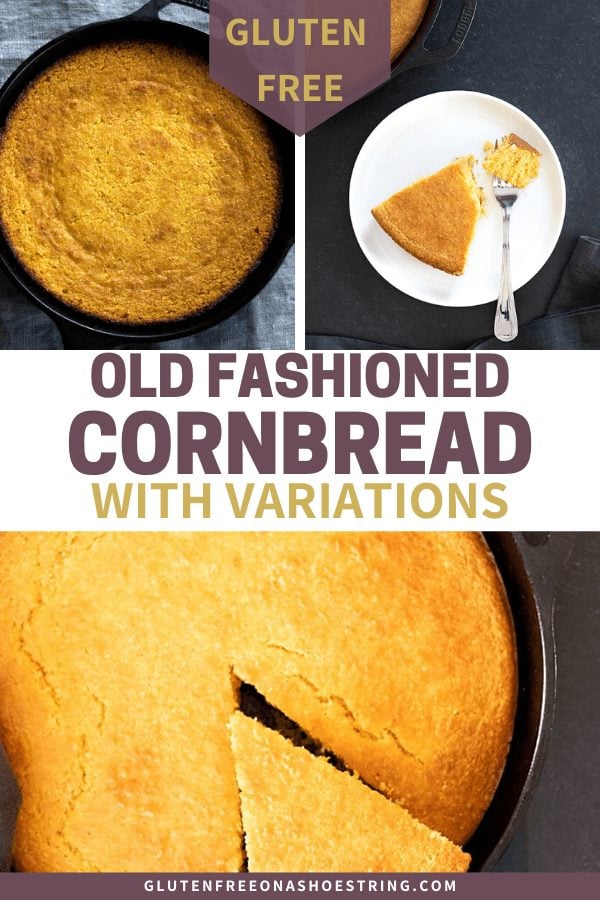

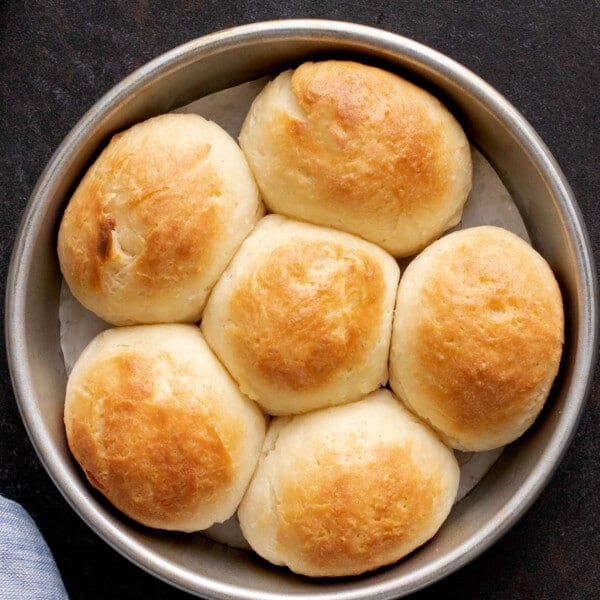
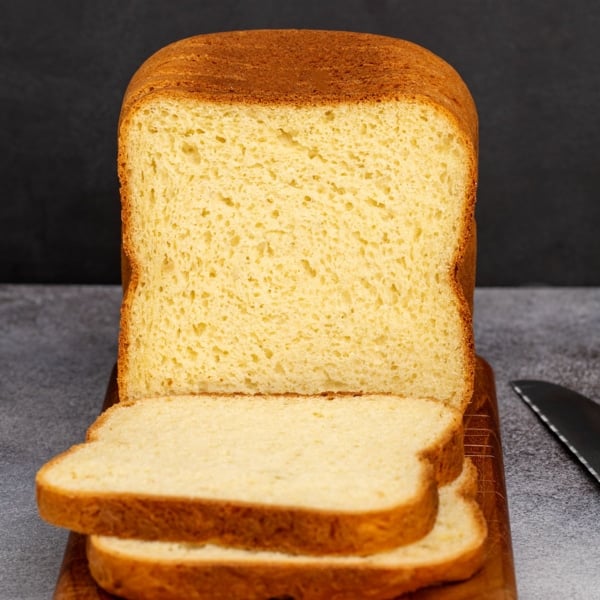
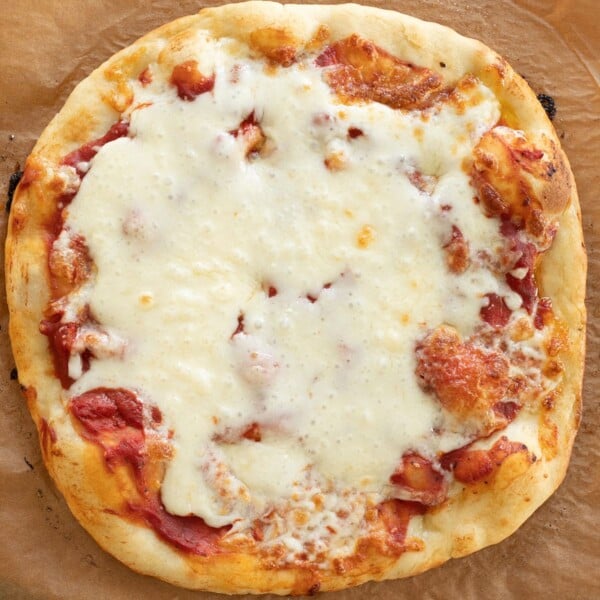
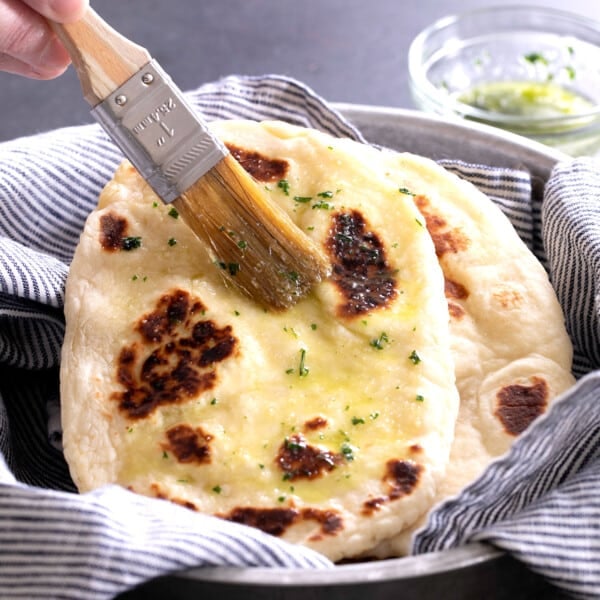









Can I use Greek yogurt?
By itself, it’s too thick/has too little moisture. You could use half Greek yogurt, half milk.
Can I add a can (or part of a can of corn kernels or mashed kernels?
I honestly don’t know, Ainsley. I’ve never tried that, but I wouldn’t recommend that you add additional liquid, since the recipe is balanced as it is.
Hello would this work in a muffin tin?
Please see the text of the post under the heading “Making gluten free cornmeal muffins”!
could i add some raspberries or blueberries to this ?
Hi, Gina, raspberries and blueberries will release quite a bit of moisture during baking, and might cause the bread to sink as it cools, so I don’t recommend that, no.
I’m truly excited to try this recipe but have 2 questions. 1) can you use ghee in place of butter? 2) can you use refined sugar in place of honey?
Hi, Cindy, I have had many readers tell me that they’ve used ghee in place of butter and granulated sugar in place of honey successfully. I’ve never tried those swaps myself, so I can’t promise exact results and always recommend making the recipe as written at least once first before making modifications.
Amazing taste and appreciated a cornbread recipe using no flour. I tried dairy free using just coconut/almond milk plus vinegar for the buttermilk but it completely crumbled when I cut into it. I’m thinking the yogurt makes a big difference so will try again with that. Otherwise, delicious recipe and thanks for taking the time to create!
Hi, Nicole
May I use olive oil instead of butter?
Thanks!
Margie
No, you can’t use a liquid oil in place of a solid fat.
I did and it turned out very delicious and not crumbly!